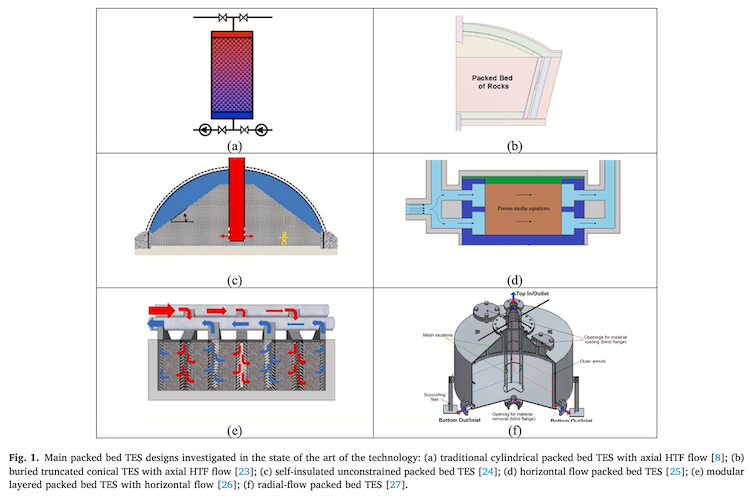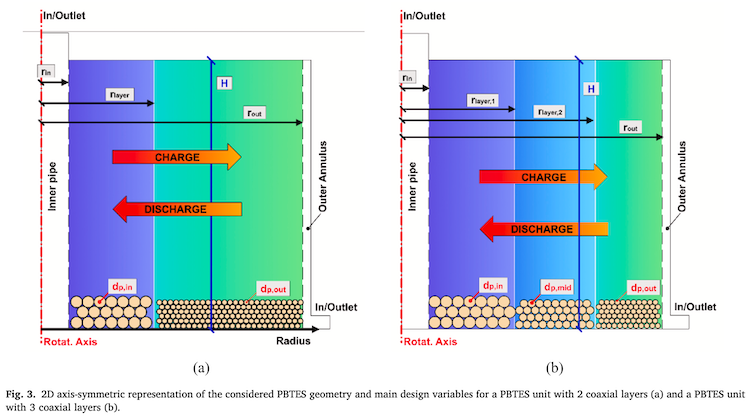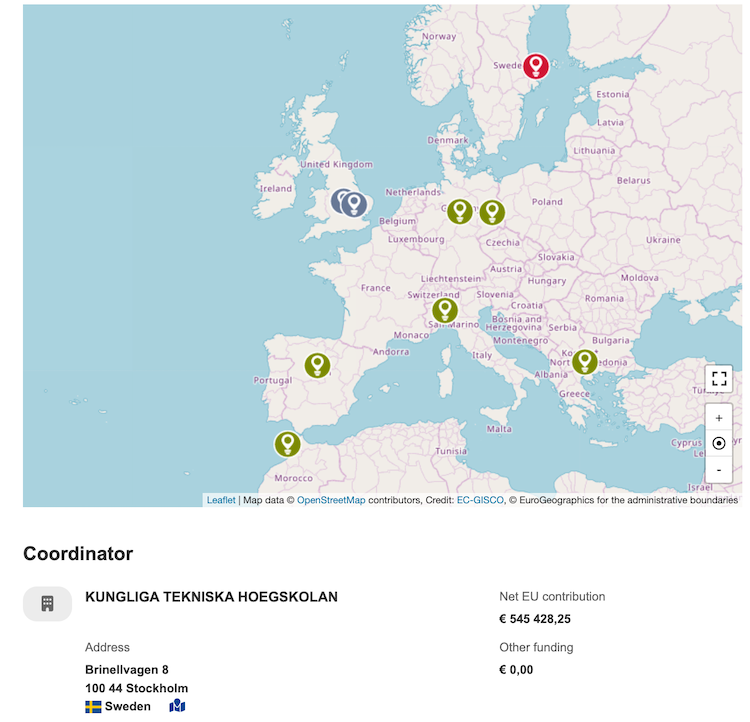
The iterations of the design for the packed bed layered radial thermal energy storage: View full size
An over 90% efficient thermal storage technology from KTH gets further refinements
Energy storage will become essential to fully replace fossil fuels for industrial heat and the electric grid. Batteries are a cost-effective solution when electricity is needed as an end-product and for a limited duration, up to a few hours. Thermal energy storage (TES) in molten salts, on the contrary, is one of the more efficient and cheaper solutions to store thermal energy for a long duration, able to discharge heat that can be used both for electricity production when coupled to a power cycle, or directly in industrial processes when heat is needed.
However, commercial molten salts have disadvantages that impose limitations for exploiting their full potential. They have a limited operational temperature window, with high freezing points at around 225°C and stability up to 600°C; they can be corrosive; and their availability and costs are subject to the demand for fertilizers, their primary market.
So, the search is on for longer duration, efficient, and even cheaper thermal storage technologies without temperature limitations and wider material availability.
Packed bed storage with the heat held in a solid material like rocks or waste slags is one approach, with a liquid or a gas like air, to get the heat in. Most are free, widely available, and can withstand extremely high temperatures.
Building on their earlier design, already over 90% in thermal energy efficiency
Over the last years, researchers at KTH in Sweden have designed and prototyped a new form of radial flow packed-bed thermal energy storage with solar-heated air to transfer heat. The concept was proven successful in the lab, and through the tests performed, researchers have identified opportunities to optimize its design further towards commercialization, which is now their primary focus.
Their studies published in 2018 showed that their original radial design could already store heat up to 800°C and attain thermal efficiencies over 90%, while reducing pressure drops by approximately half compared to more traditional axial type packed-beds of equivalent capacity.
More specific results can be found in their 2022 papers: Experimental evaluation of an innovative radial-flow high-temperature packed bed thermal energy storage published at Applied Energy and Experimental evaluation of a high-temperature radial-flow packed bed thermal energy storage under dynamic mass flow rate published in the Journal of Energy Storage.
Thermal efficiency is not the only efficiency that matters
Some electricity is also needed to pump the hot air through the rocks or pebbles. This would increase the parasitic load of a CSP plant, which is typically about 10% in commercial plants, comparable to other thermal power plants like gas or coal power plants.
“We have seen by looking into the upscaled version of the storage, particularly in typical axial packed-bed designs, that you might end up losing even up to 30% of your actual gross power production to circulate the air through the system. But if you implement changes that can reduce your pressure drop, like in our latest radial design, then you manage to cut that by half, and then it becomes a much more reasonable solution with potential for market up-take, “ said Dr. Silvia Trevisan, post-doctoral researcher leading KTH’s work in high-temperature thermal energy storage development.
“Even if axial packed-beds are inherently cheap, as they may use air and rocks, ultimately the fact that you have to consume a lot of power just to get air down through it, and possibly in discharging periods when electricity is expensive, has been one of the main factors limiting their adoption,” said Dr. Rafael Guedez, who heads the Heat and Power division at the KTH Energy department.
His team works in several collaborative and contracted research projects with industry, developing multiple technologies, with research split into four core groups: energy and industrial processes, thermal technologies, distributed energy resources, and turbomachinery and propulsion, pursuing new developments such as this radial packed-bed thermal energy storage.
“Our first radial concept helped us validate that radial configurations can significantly reduce this parasitic power consumption without sacrificing much in thermal efficiency, and the numerical results also showed that the reliability of the systems should improve when compared to axial configurations as one can avoid large gradients on the tank walls. This work helped us identify opportunities to further improve the system in its next generation, which we focus on now,” Guedez said.
Now, they are introducing refinements to the radial concept that can further reduce the power needed to pump the hot air through the solids without affecting thermal performance. They are also looking into using waste slags from the metallurgic industries as solid media, thereby increasing the circularity of the system and potentially reducing costs even further.
How the latest version works; layers of pebbles in two sizes
During charging in the radial packed bed, solar-heated air is radiated outwards from a central pipe to the tank wall annulus, passing through the bed of pebbles, and the flow is reversed during discharge (from the outer wall to the central pipe).
They tried several layers of particles or pebbles of different sizes in this latest configuration. This new design worked much better than both previous radial and axial designs for thermal energy storage alone, as their latest paper cites:
“The proposed storage unit could attain pressure drop reductions higher than 70 % with respect to uniform radial flow packed bed storage (and higher than 85 % with respect to axial flow units) at the expense of a useful duration reduction lower than 5 %.”

View full-sized image: A half view from the central pipe – shown at left in both. They compared using two different-sized pebble layers versus three. They found two layers worked as well as three, and was more straightforward and cost-effective in execution IMAGE©Design optimization of an innovative layered radial-flow high-temperature packed bed thermal energy storage.
To hold the heat in, they are now also considering using waste from the metal industry for a circular economy rather than the initial commercial ceramic material used in their first studies. Among the candidates are copper slags, a by-product from copper refining, which seem to show good thermal and mechanical properties, partly due to tiny amounts of residual iron and copper.
“We are also focusing this time on practical aspects such as loading, serviceability, and scalability, and so considering slightly modified tank geometries that we will test in the lab, thinking already of the potential when upscaled to industrial applications,” said Trevisan.
Their latest paper highlights that lab-scale models are sometimes not accurate enough to predict performance at full scale, and thus, the importance of understanding results and developing adequate methods to transfer knowledge gained from the lab into larger industrial-scale applications.
Details about the ongoing focus of their research can be seen in their latest study, Design optimization of an innovative layered radial-flow high-temperature packed bed thermal energy storage.
In the following months, and as part of the EU-funded SHARP-sCO2 project, the researchers will perform lab validation of the new layered concept using different waste materials, which will be previously assessed and pre-treated if needed. This work will be the foundation for developing a roadmap towards its demonstration at larger scales and subsequent commercialization. They expect to present updates on this work during the upcoming SolarPACES 2024 conference in Rome.
A commercialization focus at KTH
Research at KTH has a very industrial focus, resulting in innovations deployed commercially. In the field of thermal energy storage, for instance, Trevisan’s contributions have been instrumental in the optimization and further development of the technology underpinning Kyoto Group’s standalone thermal storage system, Heatcube.
“Our research is applied, we work close to industrial stakeholders, both end-users and technology developers, and we are ultimately driven both by our motivation to support net-zero as well as to create tangible impact in society, both through our research and our educational programs, which are very much connected,” said Guedez.
For this radial high-temperature packed bed, Guedez said that they are collaborating with different partners and intend to develop a roadmap to a large-scale demonstration of their over 90% efficient thermal energy storage, and later market entry of the technology once they iron out the remaining challenges.
“We expect the upcoming experimental campaign to be the basis for a larger demonstration of the system, for which we are already cooperating with Odqa Renewable Energy Technologies, a UK-based company that is also participating in the EU-funded SHARP-sCO2 project and is interested in pursuing the concept commercially,” he said.

Sweden leads the SHARP s-CO2 Project that involves research from Germany, Spain, Italy, Greece, Morocco, and partners in the UK.
Another standalone thermal energy storage tech – the Heatcube
A solar sulphur cycle to make unlimited thermal energy storage














































